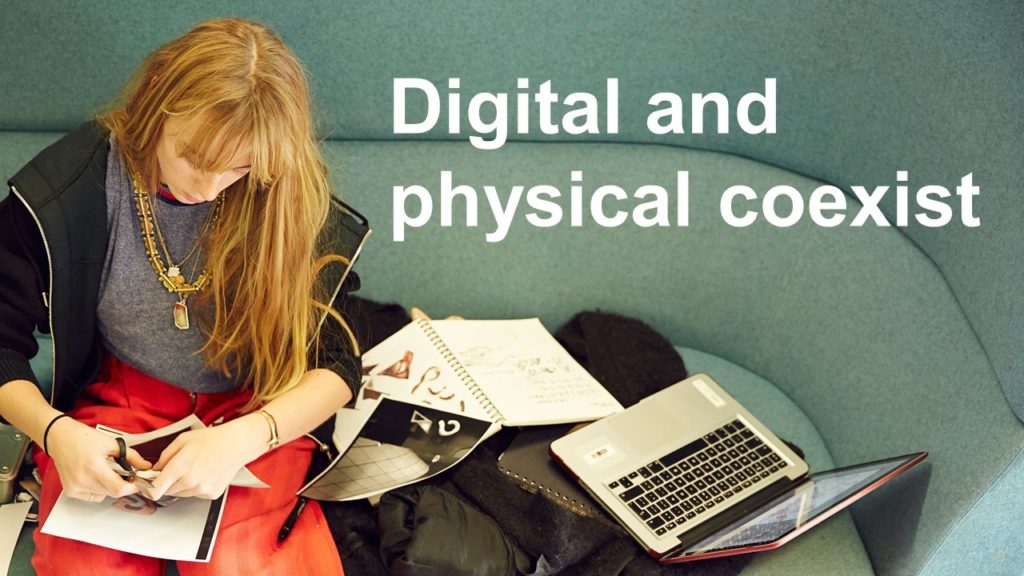Last year I wrote a quick post proposing a simple way to manage high level discussions about digital. This came from my involvement in digital strategy discussions which often slid across thematic and organisational areas, ending up with a scattering of actions which looked like a troubleshooting list and a desire to ‘get involved’ with new technology. The framework I jotted down simply proposed that discussions should understand their location within three areas: Digital Culture, Digital Medium, Digital Service.
For a recent talk I was asked to give by the Leadership Foundation on Digital Leadership I refined the framework and illustrated it with categories which sit within each area. I started with three headlines which set the context for the framework:

To harness the digital at an institutional level we have to focus on the present and not place digital in that the-next-big-thing-will-save-us category. Clearly we need to keep an eye on the horizon but I know our students would thank us if we prepared them for the digital ‘now’ not an unknown and variously utopian/dystopian imagined future.

I’ve written about this before but in summary – we need to respond to the digital as one part of the ‘real’ world not as a separate entity. Digital and non-digital activities flow in and out of each other.

It’s an element of almost everything we do and not a viable starting place for a discussion, hence the framework.

Clearly the subcategories are not exhaustive and some of the have an Art and Design twist but I hope they show how the main areas differ. What’s interesting is how decisions in one layer effect activities in the others but as institutions we struggle to make these connections. So for example we might install new technology in the service layer but neglect to discuss how this might affect teaching and learning in the Medium layer. We might make bold assertions in the Culture layer but struggle to understand the implications for the Service layer etc. This is why I think the framework is useful, assuming you can get the right mix of people from across the institution involved in discussions. Before I go any further I’ll quickly describe the layers as I see them:
Service
In a digital context this could simply be IT. It’s the layer students are most likely to comment on if asked about ‘digital’ because when most people think of digital they think the technology itself rather than their practices within digital contexts. If this layer isn’t working then the other two don’t stand a chance. There’s not much point in trying to develop a digital identity if the Wifi is down.
Medium
This is where most of our day-to-day activities take place. It’s where the digital has become the location for our work and the place where we connect with each other. This is where the real work of the institution is done, for example, teaching and learning. It’s also the layer which is often least discussed strategically as discussions swing from the need to buy more 3D printers to the risks of Social Media use and not much in between.
Culture
These are the high level principles which inform the character and direction of the institution. As is always the case with culture these are often implicit or assumed to be shared values. So, for example, in my institution we have a culture of creativity and the desire to help students develop their own creative practices. How this is expressed in the digital should be an ongoing negotiation. It’s also of note that emerging practices in the digital and new forms of access/connectedness shift culture or call aspects of it into question.
You could take the framework and use it with a second axis such as scale. So we could take teaching as a subject and consider what is needed in Culture, Medium and Service terms, mapped against Individual, Course and Institution. Or to be more specific we might take a particular question from the National Student Survey in the UK such as “My course is intellectually stimulating” and consider what is required to ensure this within that grid. Or we could map against the student journey of Pre-arrival, Induction, First year, Second Year, Third year etc. These are the kind of discussions I’d like to frame at my own institution to develop a better shared understanding of the digital which cuts across traditional structural areas such as IT, Teaching and Learning and Senior Management.
The framework was well received at the Leadership Foundation event I presented at. I hope it proves to be useful. Thanks to the many colleagues who listened to me as I was formulating the framework and offered useful feedback and advice.